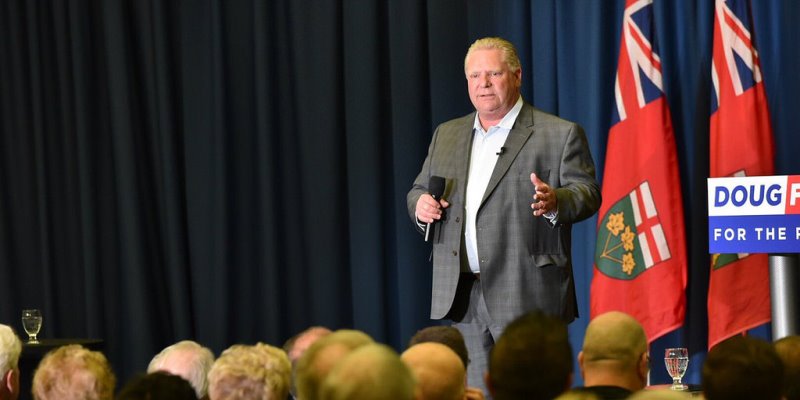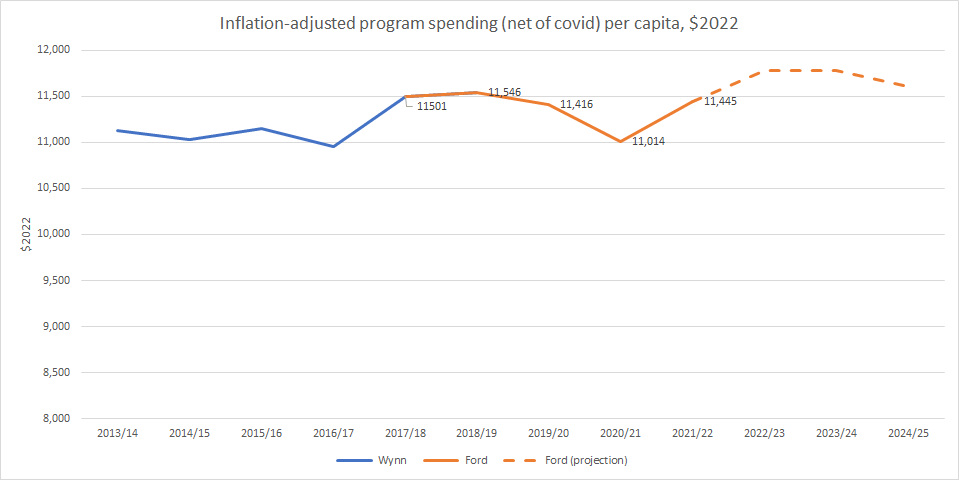Ontario government poised to outspend predecessor

Several past analyses have shown that since first taking office in 2018, the Ford government has largely continued the approach of its predecessors with respect to several dimensions of Ontario fiscal policy. Even setting aside emergency measures related to the pandemic and recession, the government has followed a similar pattern of spending increases and debt accumulation as its predecessors.
Indeed, a recent study shows that the Ford government’s actually plans to exceed the highest spending levels reached at any point during Premier Wynne’s time in office.
First, let’s look at the Ford government’s pre-pandemic spending trajectory. In 2018/19 and 2019/20, the government held spending (inflation-adjusted per-person) at almost exactly the same level as its predecessors. More precisely, in the last year of the Wynne government per-person program spending (in 2022 dollars) was $11,501. In the final year before the pandemic transformed government finances, the Ford government spent $11,416 per person.
The 2020/21 fiscal year is anomalous because of COVID-related spending and transfers from the federal government. It’s therefore difficult to compare spending that year to the ones prior or since. So it’s more useful to pay attention to 2021/22 when per-person program spending stood at $11,445. Again, almost exactly the same amount (after accounting for inflation and population growth) as the Ford government inherited from its predecessors.
In short, although the Progressive Conservatives were fiercely critical of the Wynne government in opposition for overspending, they essentially maintained spending levels they inherited when they were elected.
The 2022 budget, however, suggests the Ford government’s biggest spending days are ahead, with the current fiscal plan calling for per-person spending (inflation-adjusted) in each of the next three years to reach a higher level than at any point during the Wynne government’s time in office. Rhetoric aside, the PCs are on track to outspend Premier Wynne.

While the budget calls for spending growth in 2022/23, with a small reduction in the following two years, even these promises of mild restraint in subsequent years should be taken with a grain of salt. It’s common for governments to spend money today but promise more discipline in the future. We’ve certainly gone seen that in Ontario many times, and should be skeptical of promises of future restraint.
A few caveats are in order. We are in a very uncertain economic time and many of the budget’s economic projections are already extremely unlikely to materialize. Inflation, for instance, will almost certainly be higher than the government thought in the Spring. So it’s possible, if the government resists the urge to spend more freely as extra dollars roll in from increased tax revenue resulting from inflation, that inflation-adjusted per-person spending will actually wind up lower than expected. There are many such examples of uncertainty in today’s economy.
With that said, our best information about the Ford government’s likely approach to its second term lies in its 2022 budget, which tells a clear story about the government’s fiscal management stance. Following four years of mimicking the Wynne government on government spending, the Ford government intends to go a step further and outspend its predecessor throughout its second term.

